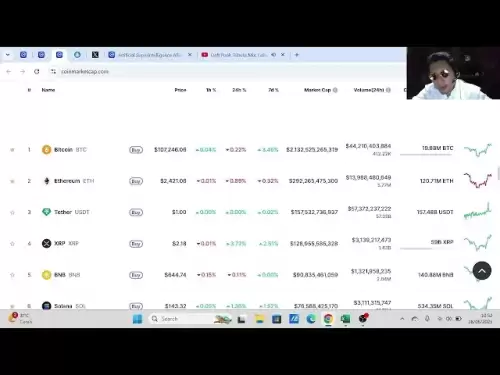-
 Bitcoin
Bitcoin $107,352.1067
0.28% -
 Ethereum
Ethereum $2,429.3531
-0.90% -
 Tether USDt
Tether USDt $1.0001
-0.02% -
 XRP
XRP $2.1894
4.62% -
 BNB
BNB $646.7968
0.36% -
 Solana
Solana $147.4290
4.03% -
 USDC
USDC $0.9998
-0.02% -
 TRON
TRON $0.2756
1.52% -
 Dogecoin
Dogecoin $0.1630
1.14% -
 Cardano
Cardano $0.5612
1.18% -
 Hyperliquid
Hyperliquid $37.0580
-0.05% -
 Bitcoin Cash
Bitcoin Cash $496.9410
-0.09% -
 Sui
Sui $2.7318
3.19% -
 Chainlink
Chainlink $13.1503
0.58% -
 UNUS SED LEO
UNUS SED LEO $9.0766
0.55% -
 Avalanche
Avalanche $17.7220
1.46% -
 Stellar
Stellar $0.2380
1.52% -
 Toncoin
Toncoin $2.8439
0.38% -
 Shiba Inu
Shiba Inu $0.0...01143
1.84% -
 Litecoin
Litecoin $85.8053
1.47% -
 Hedera
Hedera $0.1483
2.70% -
 Monero
Monero $314.3240
2.12% -
 Bitget Token
Bitget Token $4.6725
0.77% -
 Dai
Dai $1.0000
0.00% -
 Polkadot
Polkadot $3.3555
1.28% -
 Ethena USDe
Ethena USDe $1.0001
0.02% -
 Uniswap
Uniswap $7.0890
2.64% -
 Pi
Pi $0.5355
-3.40% -
 Pepe
Pepe $0.0...09393
1.06% -
 Aave
Aave $256.8136
-1.90%
How do the big guys in the currency circle make money?
Experienced cryptocurrency investors employ a multifaceted approach to market analysis, leveraging technical analysis, fundamental factors, and quantitative modeling to predict future price movements and identify profitable opportunities.
Jan 09, 2025 at 05:52 pm

Key Points of the Article
- Understanding the strategies and methods employed by experienced cryptocurrency investors
- Exploring various investment strategies used to generate substantial returns
- Identifying the nuances of market analysis, trade execution, and risk management
How Do the Big Guys in the Currency Circle Make Money?
While the cryptocurrency market presents ample opportunities for growth, navigating its complexities requires a comprehensive understanding of the strategies adopted by successful investors. Below are detailed explanations of the methods employed by veterans in the currency circle:
1. Market Analysis and Research:
A cornerstone of successful cryptocurrency investing involves meticulously studying market trends and conducting thorough research. Elite investors employ a multifaceted approach to analyzing market conditions, including technical analysis, fundamental factors, and quantitative modeling. Technical analysis examines historical price patterns and market indicators to predict future price movements. Fundamental analysis delves into a cryptocurrency's underlying technology, team, and market adoption to assess its long-term viability. Quantitative modeling harnesses statistical tools and algorithms to identify trading opportunities and optimize portfolio allocation.
2. Diversification and Asset Allocation:
Seasoned cryptocurrency investors recognize the importance of diversifying their portfolio to mitigate risks. Diversification involves allocating funds across a spectrum of cryptocurrencies, asset classes, and investment strategies. Asset allocation entails strategically distributing investments based on risk tolerance, investment horizon, and financial goals. Effective diversification lowers portfolio volatility, enhances overall returns, and protects against significant losses during market downturns.
3. Market Making and Arbitrage:
Market making involves buying and selling cryptocurrencies, providing liquidity to exchanges and profiting from bid-ask spreads. Arbitrage, on the other hand, entails capitalizing on price discrepancies between exchanges by simultaneously buying and selling the same asset to lock in risk-free profits. Both strategies require a profound understanding of market dynamics, low latency trading platforms, and the ability to accurately assess asset valuations.
4. High-Speed Trading and Algorithmic Execution:
In the fast-paced world of cryptocurrency trading, milliseconds can make all the difference. High-speed trading utilizes advanced hardware and software to execute trades at lightning speeds, often leveraging algorithmic models to automate trading decisions. Algorithmic execution employs a set of pre-defined instructions to execute trades, offering precision, efficiency, and the ability to execute complex trading strategies in real-time.
5. OTC Trading and Private Placements:
Over-the-counter (OTC) trading, handled outside of centralized exchanges, enables large transactions between institutional investors without impacting the broader market. Private placements, similar to OTC trades, connect investors directly with cryptocurrency issuers to facilitate capital raising. These exclusive opportunities typically provide investors with access to early-stage projects and potentially higher returns
6. Staking and Yield Farming:
Staking involves committing cryptocurrencies to a blockchain network to support its operations. Staked cryptocurrencies are used to verify transactions and can earn passive rewards for holders. Yield farming involves lending or providing liquidity to decentralized finance (DeFi) protocols, which generate yield by facilitating cryptocurrency transactions and lending services. Both staking and yield farming mechanisms offer passive income opportunities in the cryptocurrency sphere.
FAQs
- What is high-frequency trading (HFT)?
HFT is a form of high-speed trading characterized by extremely fast execution speeds, often measured in microseconds.
- What are the risks of OTC trading?
OTC trades lack the transparency and liquidity of centralized exchanges, potentially increasing the risk of counterparty defaults and manipulation.
- What are the benefits of staking?
Staking rewards are typically paid in the same cryptocurrency that is staked and can contribute to portfolio growth over time, enhancing long-term returns.
- What is the difference between market making and arbitrage?
Market making involves profiting from spreads by providing liquidity, while arbitrage capitalizes on price discrepancies by simultaneously buying and selling an asset across different exchanges or markets.
- What are the key factors considered in asset allocation strategies?
Asset allocation for cryptocurrency investments should consider the investor's risk tolerance, time horizon, financial goals, and market conditions.
Disclaimer:info@kdj.com
The information provided is not trading advice. kdj.com does not assume any responsibility for any investments made based on the information provided in this article. Cryptocurrencies are highly volatile and it is highly recommended that you invest with caution after thorough research!
If you believe that the content used on this website infringes your copyright, please contact us immediately (info@kdj.com) and we will delete it promptly.
- SEI Mirroring Solana: Price Spikes and the Next Big Crypto?
- 2025-06-28 20:52:13
- PENGU Price Surges: Are Whales Targeting $0.0149?
- 2025-06-28 20:30:12
- Notcoin's Wild Ride: Price Swings, Market Cap, and What's Next
- 2025-06-28 20:30:12
- COMP Price Wobbles as a16z Moves Tokens Amid Crypto Jitters
- 2025-06-28 20:52:13
- Bitcoin, XRP, and Macro Trends: Navigating the Crypto Landscape in 2025 and Beyond
- 2025-06-28 20:55:12
- Navigating Offshore Casinos: A Safe Haven for US Players?
- 2025-06-28 20:55:12
Related knowledge
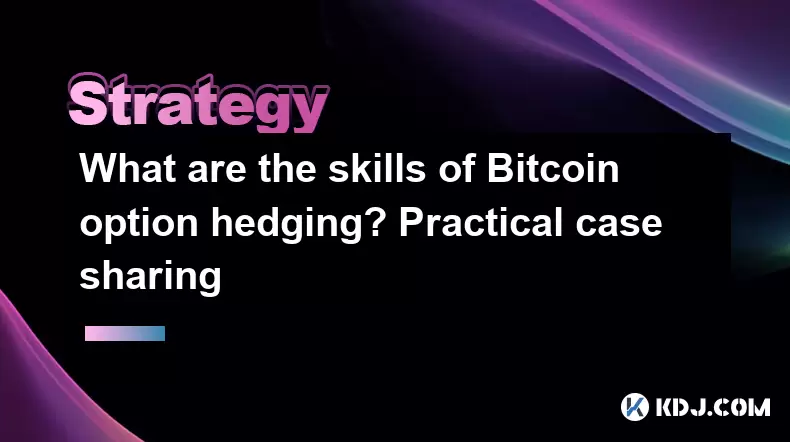
What are the skills of Bitcoin option hedging? Practical case sharing
Jun 24,2025 at 04:01pm
Understanding Bitcoin Option HedgingBitcoin option hedging is a risk management strategy used by traders and investors to protect their positions in the volatile cryptocurrency market. By using options, individuals can limit potential losses while retaining the opportunity for profit. In essence, it allows one to insulate against adverse price movements...
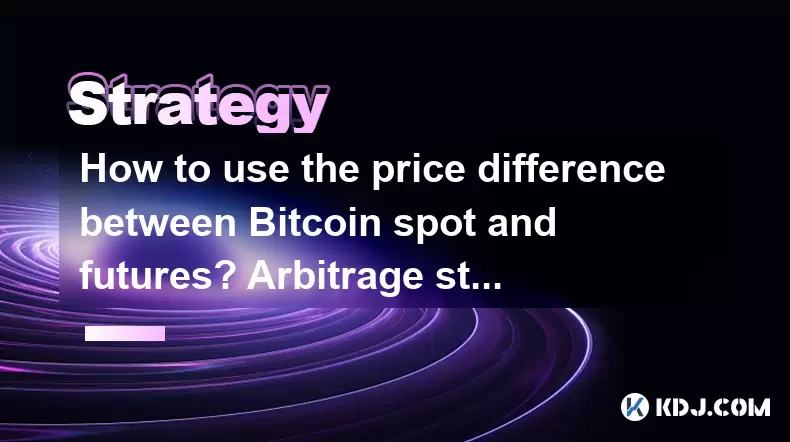
How to use the price difference between Bitcoin spot and futures? Arbitrage strategy
Jun 20,2025 at 02:56pm
Understanding Bitcoin Spot and Futures MarketsTo effectively leverage arbitrage opportunities between Bitcoin spot and futures markets, it's essential to understand the fundamental differences between these two types of markets. The spot market refers to the direct buying and selling of Bitcoin for immediate delivery at the current market price. In cont...
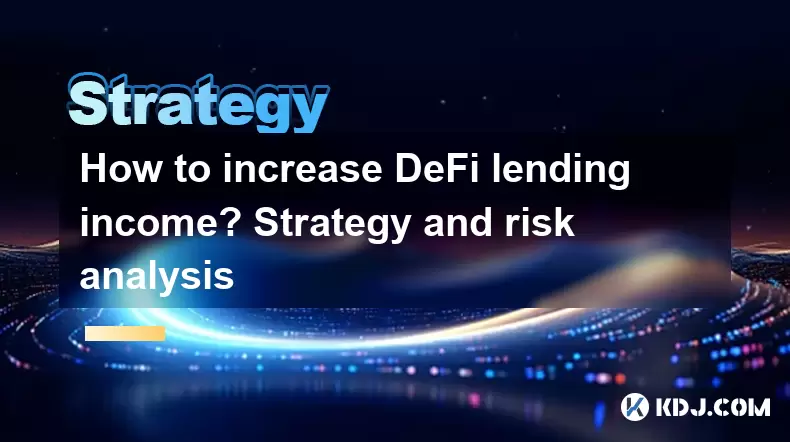
How to increase DeFi lending income? Strategy and risk analysis
Jun 24,2025 at 02:08pm
Understanding DeFi Lending and Its Income PotentialDeFi (Decentralized Finance) lending has emerged as a popular way to earn passive income in the cryptocurrency space. Unlike traditional banking systems, DeFi lending platforms allow users to lend their crypto assets directly to borrowers without intermediaries. The lenders earn interest based on the su...
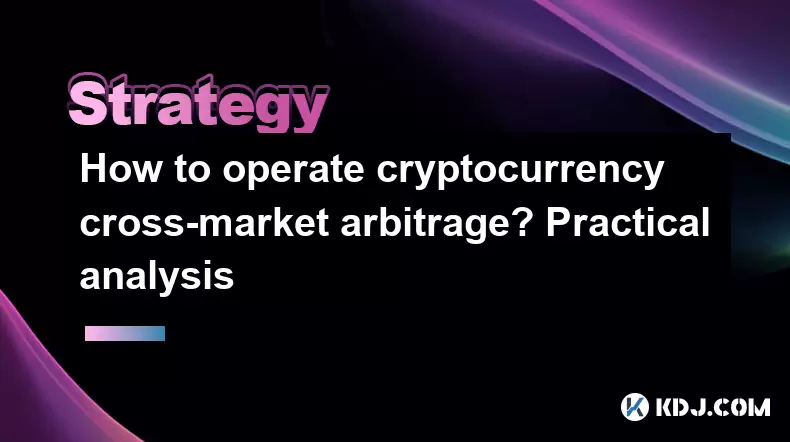
How to operate cryptocurrency cross-market arbitrage? Practical analysis
Jun 23,2025 at 04:01am
Understanding Cryptocurrency Cross-Market ArbitrageCryptocurrency cross-market arbitrage involves taking advantage of price differences for the same digital asset across different exchanges. The core idea is to buy low on one exchange and sell high on another, capturing the profit from the discrepancy. This strategy relies heavily on real-time market da...

How to make profits from high-frequency cryptocurrency trading? Sharing core skills
Jun 19,2025 at 05:07pm
Understanding High-Frequency Cryptocurrency TradingHigh-frequency trading (HFT) in the cryptocurrency market involves executing a large number of trades at extremely fast speeds, often within milliseconds. This method relies on small price discrepancies across exchanges or within a single exchange’s order book. Traders use complex algorithms and ultra-l...
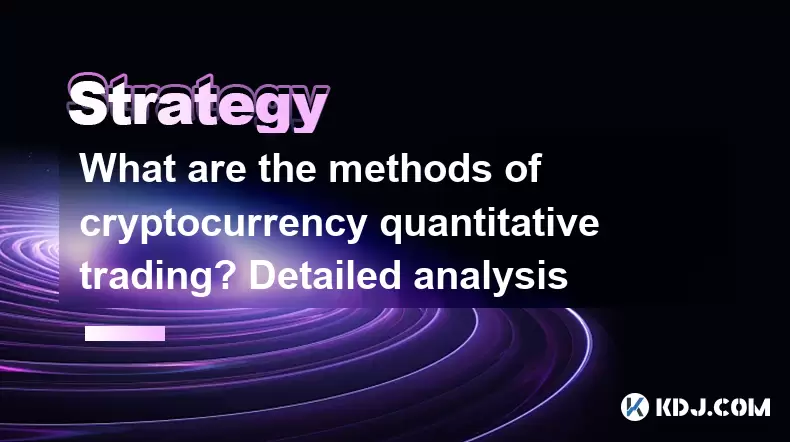
What are the methods of cryptocurrency quantitative trading? Detailed analysis
Jun 22,2025 at 11:07pm
Understanding the Core of Cryptocurrency Quantitative TradingCryptocurrency quantitative trading refers to the use of mathematical models and algorithms to execute trades in the digital asset market. Unlike traditional discretionary trading, which relies heavily on human judgment, quantitative trading leverages data-driven strategies to identify profita...

What are the skills of Bitcoin option hedging? Practical case sharing
Jun 24,2025 at 04:01pm
Understanding Bitcoin Option HedgingBitcoin option hedging is a risk management strategy used by traders and investors to protect their positions in the volatile cryptocurrency market. By using options, individuals can limit potential losses while retaining the opportunity for profit. In essence, it allows one to insulate against adverse price movements...

How to use the price difference between Bitcoin spot and futures? Arbitrage strategy
Jun 20,2025 at 02:56pm
Understanding Bitcoin Spot and Futures MarketsTo effectively leverage arbitrage opportunities between Bitcoin spot and futures markets, it's essential to understand the fundamental differences between these two types of markets. The spot market refers to the direct buying and selling of Bitcoin for immediate delivery at the current market price. In cont...

How to increase DeFi lending income? Strategy and risk analysis
Jun 24,2025 at 02:08pm
Understanding DeFi Lending and Its Income PotentialDeFi (Decentralized Finance) lending has emerged as a popular way to earn passive income in the cryptocurrency space. Unlike traditional banking systems, DeFi lending platforms allow users to lend their crypto assets directly to borrowers without intermediaries. The lenders earn interest based on the su...

How to operate cryptocurrency cross-market arbitrage? Practical analysis
Jun 23,2025 at 04:01am
Understanding Cryptocurrency Cross-Market ArbitrageCryptocurrency cross-market arbitrage involves taking advantage of price differences for the same digital asset across different exchanges. The core idea is to buy low on one exchange and sell high on another, capturing the profit from the discrepancy. This strategy relies heavily on real-time market da...

How to make profits from high-frequency cryptocurrency trading? Sharing core skills
Jun 19,2025 at 05:07pm
Understanding High-Frequency Cryptocurrency TradingHigh-frequency trading (HFT) in the cryptocurrency market involves executing a large number of trades at extremely fast speeds, often within milliseconds. This method relies on small price discrepancies across exchanges or within a single exchange’s order book. Traders use complex algorithms and ultra-l...

What are the methods of cryptocurrency quantitative trading? Detailed analysis
Jun 22,2025 at 11:07pm
Understanding the Core of Cryptocurrency Quantitative TradingCryptocurrency quantitative trading refers to the use of mathematical models and algorithms to execute trades in the digital asset market. Unlike traditional discretionary trading, which relies heavily on human judgment, quantitative trading leverages data-driven strategies to identify profita...
See all articles























